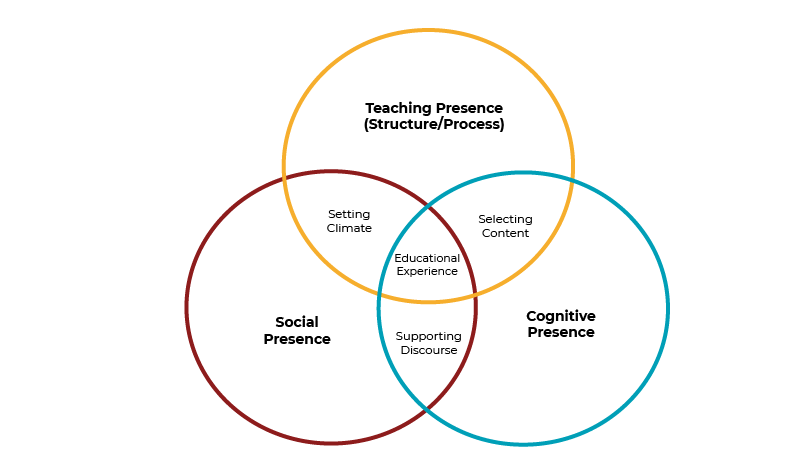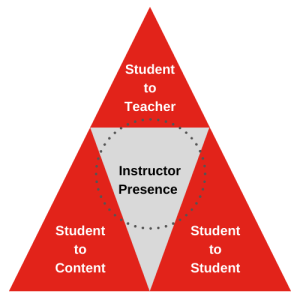
![]() KEY CONCEPT
KEY CONCEPT
Humans learn best when they learn in a community featuring social, cognitive, and teaching presence (High-Quality Online Courses).
Defining Teacher Presence
Creating presence is a central concept in online learning, and it’s often one of the most overlooked and underestimated aspects of building a learning experience because it doesn’t happen without some forethought and planning.
As a result, educators often grapple with questions about effectiveness and engagement. Where does the learning happen? By reading texts or viewing lectures online? Through discussions with peers and facilitators? In self-organized “study groups” or chat sessions? What types of learning environments best support a full range of these activities? At the very heart of the matter is the broadly accepted view that people learn best in the context of networks or communities of people.
A very useful schema for thinking about the creation of an effective online educational community was developed by Garrison, Anderson and Archer (2000) based on extensive qualitative and quantitative research work undertaken at the University of Alberta. This conceptual model is called the “community of inquiry” (COI) model (UBC Wiki).

This model postulates that deep and meaningful learning results when there are sufficient levels of three inter-related “presences” in a virtual learning environment:
- Social presence: this relates to the creation of a supportive environment in which learners feel able to express their ideas and collaborate on the construction of new knowledge. In the absence of social presence, learners feel unable to disagree, share viewpoints, explore differences or accept support and confirmation from peers or facilitators.
- Cognitive presence: this is the creation of an environment that promotes critical thinking in relation to the content area at hand.
- Teaching presence: describes the creation of an instructional relationship appropriate to the learning community and the topic at hand. It is defined as the “design, facilitation, and direction of cognitive and social processes for the purpose of realizing personally meaningful and educationally worthwhile learning outcomes.”(UBC Wiki).
When all three elements interact, it’s then that students are able to experience deep and meaningful learning. In the COI model, the instructor plays a key role in both ‘setting the climate’ and ‘selecting the content’ of an educational experience.
You might also like to explore the Community of Inquiry Website that summarizes these ideas and links each summary to the authors’ more detailed papers on the topic.
What about Engagement?
Let’s not forget about student engagement. “Other bodies of research suggest presence is a key factor to engagement, another metric for predicting student success in online coursework. Presence in this context also considers student perceptions of instructor involvement as a central factor. High levels of engagement, studies indicate, lead to higher levels of student achievement, greater likelihood of graduation, and deeper satisfaction” with the learning experience overall (Oblinger qtd in Morrison).
Online Teaching Triangle
Instructional design plays an important role in the creation of “presence and a community. As the instructor, you’re responsible for selecting the content, supporting the discourse of learning, setting the climate for your course, and defining the structure and process for learning the material— it’s a daunting task, to be sure.
How Can I Design My Course?

A well-organized online course may aim to follow a 3-part model of interaction and design to promote a balance of presence and engagement. You can think of the approach as a teaching triangle. In order to create this approach, design your course so that it has a balance of interaction as follows: between the student and the teacher (35%), between the student and the course content (40%) and between students to other students (35%). Of course, the percentages are just a suggestion; depending on the type of course/discipline you teach, the interaction/balance may vary. For example, a skills-based course may require a higher volume of group work, collaboration, and student interaction to complete a capstone project or as part of the course/program’s learning outcomes.
How Do I Implement the Triangle?
The balance of presence can be accomplished by using a variety of assignment & evaluation types and authentic assessment opportunities, as well as an effective course layout and design strategy that promotes interaction and instructor/student presence.
 TIP: For a more comprehensive look at teaching guidance, preparing materials for learning, and designing assessment strategies, check out Fanshawe’s Code Book (requires myFanshawe Login) on Course Development.
TIP: For a more comprehensive look at teaching guidance, preparing materials for learning, and designing assessment strategies, check out Fanshawe’s Code Book (requires myFanshawe Login) on Course Development.
Additional Resources

- “3. The role of presence in online teaching” in #Openteach: professional development for open online educators by #Openteach
- “2 Where’s the Teacher? Defining the Role of Instructor Presence in Social Presence and Cognition in Online Education” in Humanizing Online Teaching and Learning by Whitney Kilgore.
- Online Instructor Presence from the Teaching and Learning Resource Center at The Ohio State University
- COI Model from Athabasca University
- Creating an Effective Online Instructor Presence (PDF) from Columbia University
- Teaching Presence in Online Education from OLJ: The Official Journal of OLC
References
- “4.3 Introduction to the Community of Inquiry framework” in High Quality Online Courses by the University of Waterloo; Queen’s University; University of Toronto; and Conestoga College is licensed under a Creative Commons Attribution-NonCommercial-ShareAlike 4.0 International License, except where otherwise noted.
- Morrison, D. (2014, September 29). Community of inquiry model. Online Learning Insights. https://onlinelearninginsights.wordpress.com/tag/community-of-inquiry-model/
- UBC Wiki. (2010, August 20). Creating the online learning environment/teaching in an online context. Documentation: Creating the Online Learning Environment/Teaching in an Online Context – UBC Wiki. https://wiki.ubc.ca/Documentation:Creating_the_Online_Learning_Environment/Teaching_in_an_Online_Context
- Garrison, D. R., Anderson, T., & Archer, W. (2000). Critical inquiry in a text-based environment: Computer conferencing in higher education model. The Internet and Higher Education, 2(2-3), 87-105.
- Garrison, D. R. (2007). Online community of inquiry review: Social, cognitive, and teaching presence issues. Journal of Asynchronous Learning Networks, 11(1), 61-7

